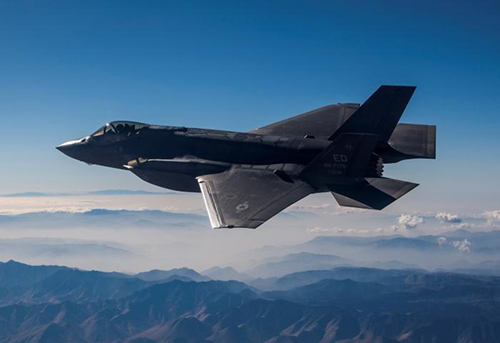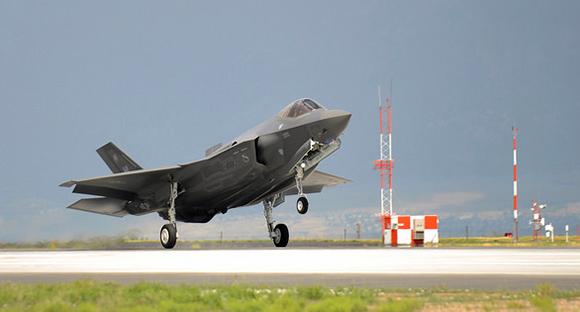The F-35A could be immediately deployed abroad as soon as it has reached the Initial Operational Capacity scheduled for August of 2016. General Hawk Carlisle, head of Air Combat Command, will decide the operational deployment of the fighter, as reported by AirForceTimes.
The first squadron will initially perform three mission profiles: close air support, interdiction, suppression and destruction of enemy air defenses. The Air Force features 74 F-35A and more than 2.000 trained technicians.
The development strategy of the JSF program is based on the implementation of software that from time to time increases platform capabilities. Funds for the final Block-4 have been allocated to date. The F-35 flying in the 2040 will be equipped with Block-7.
The 1A / 1B Block includes the 78 percent of the source code necessary for the F-35 Initial Operating Skills by providing training software and primary interaction between the various main systems. The 40% of the fleet has currently "loaded" the Block-2A software. Increases the aircraft's overall capabilities for pilot training including off-board fusion capabilities, initial data links, electronic countermeasures and improved debrief.
With the 2A block, 86 per cent of the code necessary to reach the Initial Operational Capacity is provided. The Marine Corps with the F-35B has reached the Initial Operational Capacity with the 2B software block. The 2B provides basic Close Air Support with the possibility of launching AMRAAM (Advanced Medium Range Air to Air Missile), JDAM (Joint Direct Attack Munition) and GBU-12 (laser-guided aerial bomb). At the 15 in September, the 60% of the American F-35 fleet loaded the 2B. It should be noted that the F-35B in service with the Marines is equipped with a special version of the Block 2B software. The Marine squadron, called '1 Group', presents most of the hardware changes already implemented (and that tomorrow will be integrated into mass production) such as reinforced bulkheads. The aircraft could go into battle with 'reduced' equipment: AIM-120 AMRAAM missiles, GBU-12 bombs and GBU-39. The Air Force plans to achieve Initial Operational Capacity with the F-35A in the 2016 with the next iteration of the software, called 3i.
 Described as a technical update of the Block-2B, the 3i will allow the aircraft to use JDAM, GBU-12 and AMRAAM. The F-35A will have substantial air support capabilities only in the 2018, when it reaches Full Operational Capability. Only in the 2019 (except for sensational delays), the F-35A can fire with the internal cannon and release a series of ammunition including AIM-9X, AMRAAM, GBU-12, GBU-31 and Small Diameter Bomb II. The Block 3F software will provide the 100 per cent of the 'Warfighting' capabilities of the fighter, with total integration of all external systems. The Block 3F was written, according to the latest information from Lockheed, and is being tested. The SDB-II system will be integrated with the Block-4a software.
Described as a technical update of the Block-2B, the 3i will allow the aircraft to use JDAM, GBU-12 and AMRAAM. The F-35A will have substantial air support capabilities only in the 2018, when it reaches Full Operational Capability. Only in the 2019 (except for sensational delays), the F-35A can fire with the internal cannon and release a series of ammunition including AIM-9X, AMRAAM, GBU-12, GBU-31 and Small Diameter Bomb II. The Block 3F software will provide the 100 per cent of the 'Warfighting' capabilities of the fighter, with total integration of all external systems. The Block 3F was written, according to the latest information from Lockheed, and is being tested. The SDB-II system will be integrated with the Block-4a software.
The 4 Block will be divided into two segments. The Block-4a will be ready between the 2021 and the 2022, while the 4B for the 2023. The twelve million dollars to write the Block-4 have been included in the 2014 budget. Much of the development of the Block-4 will be dedicated to countermeasures against existing enemy air defense systems and those that will arise in future years.
Lockheed delivered 33 of the 340 F-35B purchased by the Marine Corps in addition to the 80 F-35C to be deployed on the aircraft carriers. The Marines have more than fifty pilots qualified for the F-35 and more than 400 military specialists in maintenance. According to the Marine Corps Aviation Plan, the F-35 will replace the entire EA-6B Prowler fleet within the 2019 and will displace the AV-8B Harrier from the 2026. Finally, the F-35 will detect the F / A-18 Hornets in the 2030.
The Air Force will reach the Initial Operative Capacity of the F-35A as soon as the first squad consisting of 12-24 aircraft will be formed, with trained aviators and crews able to perform close air support missions, interdiction and limited suppression and destruction of enemy anti-aircraft defenses. The F-35A will reach the Initial Operational Capacity between August and December of the 2016.
Finally, the US Navy, equipped with the F-35C, will reach the Initial Operational Capacity as soon as the first squadron composed of 10 aircraft has been formed, with personnel and navy pilots trained and able to carry out the assigned missions. The F-35C will reach the Initial Operational Capacity between August 2018 and February 2019.
The 55 years of life of the F-35 hunt will cost US $ 1500 billions of dollars.
In addition to the United States, hunting has been ordered from Great Britain, Australia, Italy, Turkey, Norway, the Netherlands, Japan, South Korea and Israel.
(photo: US Air Force / Lockheed Martin)












